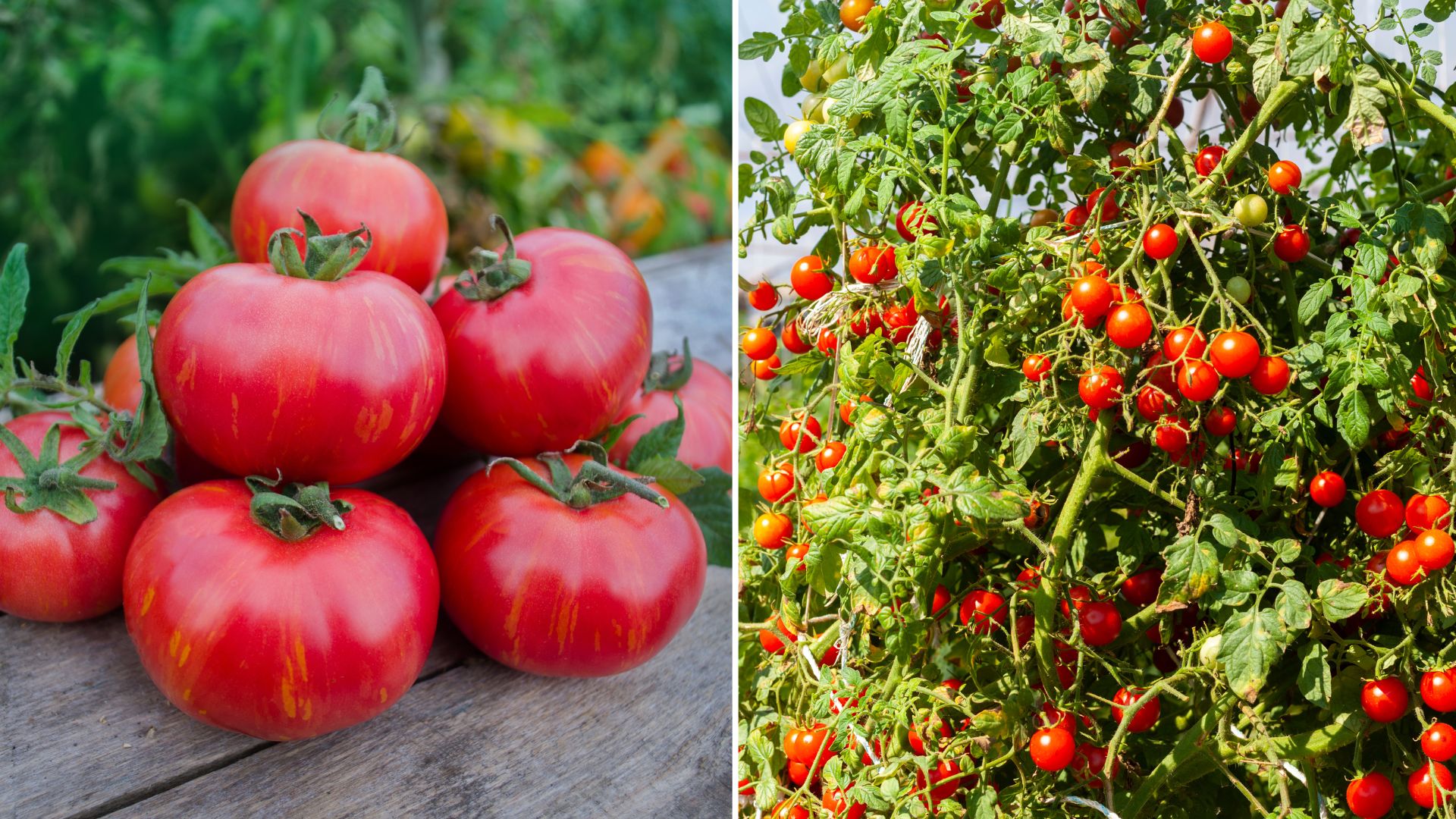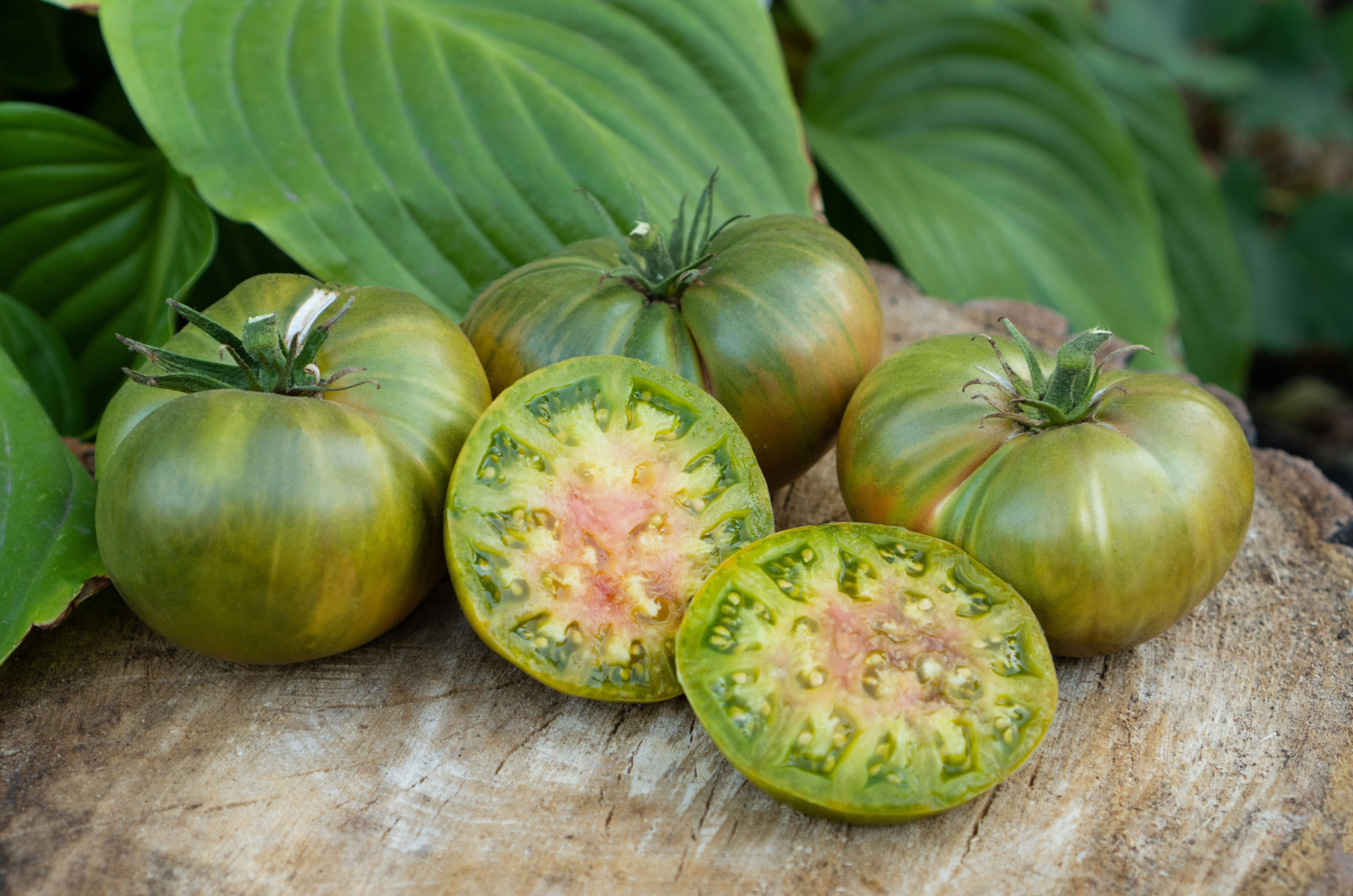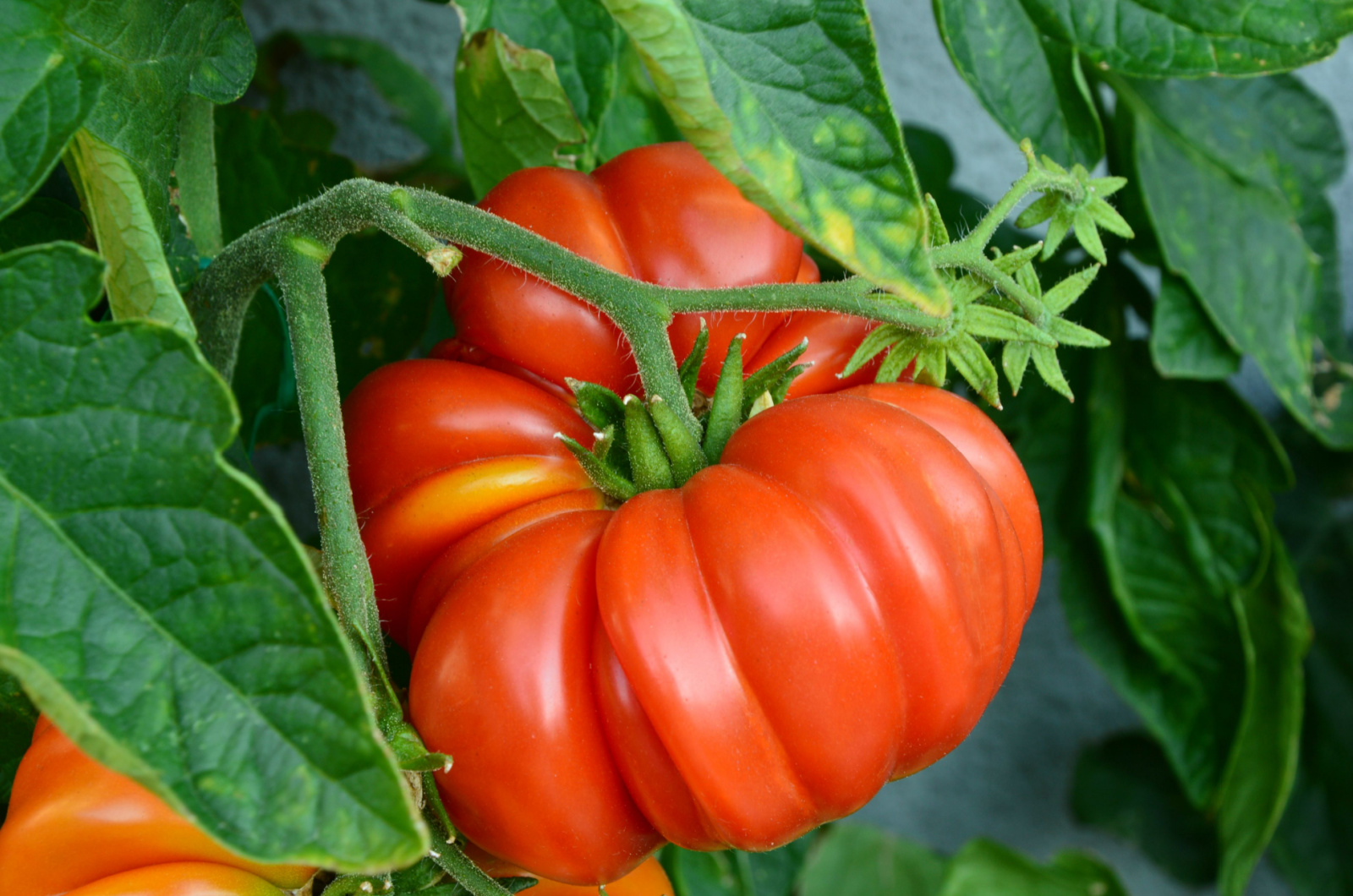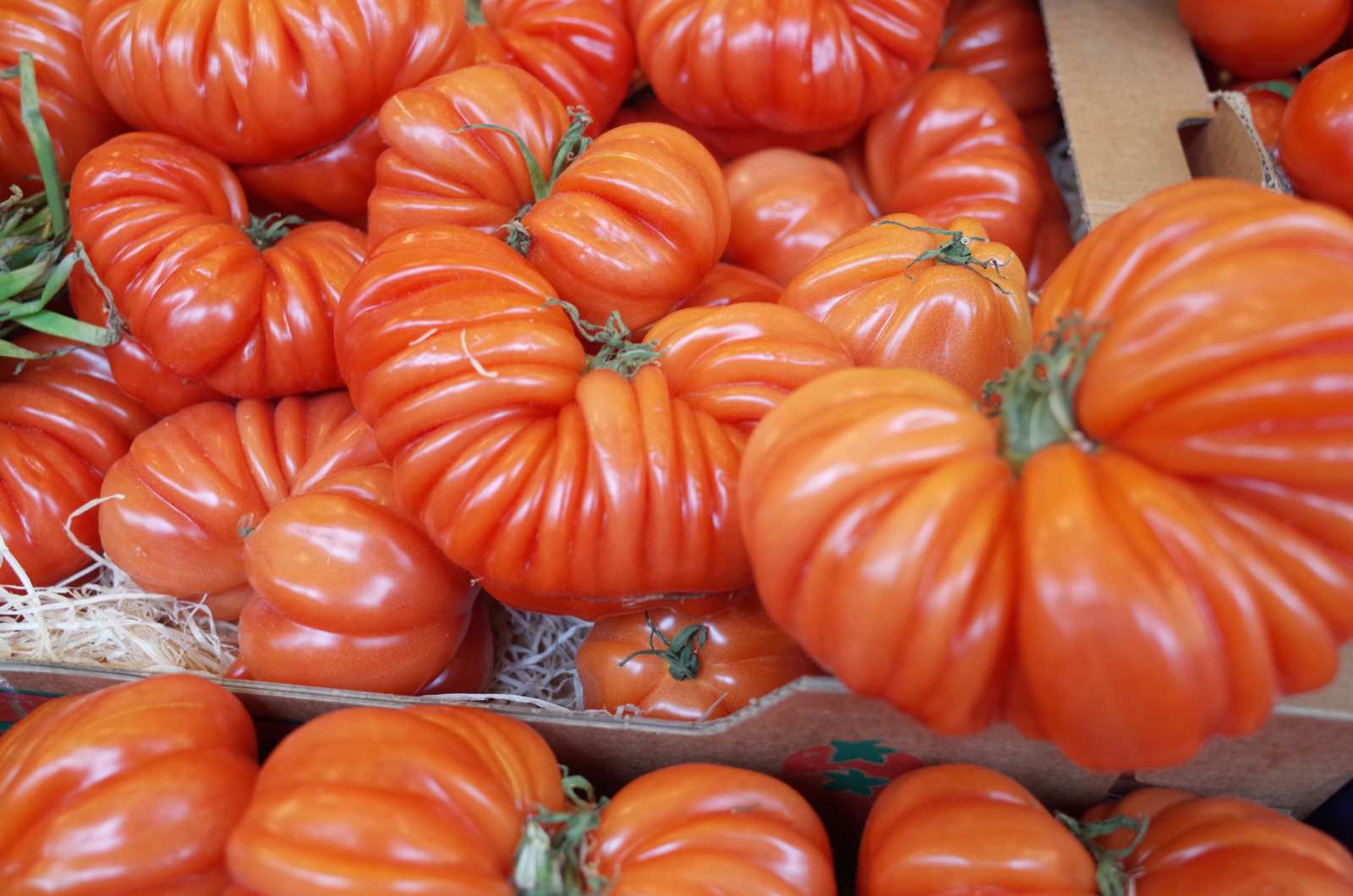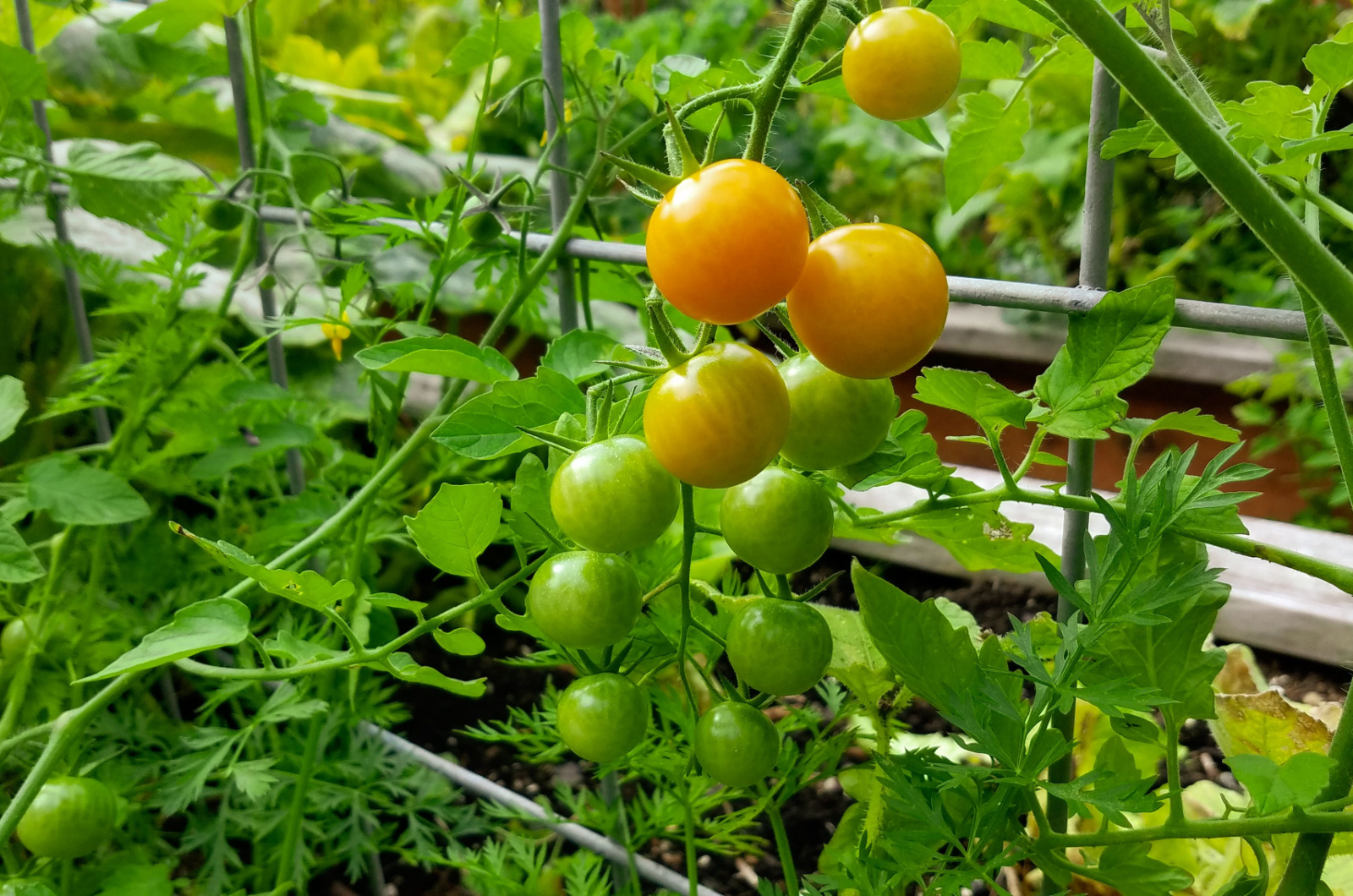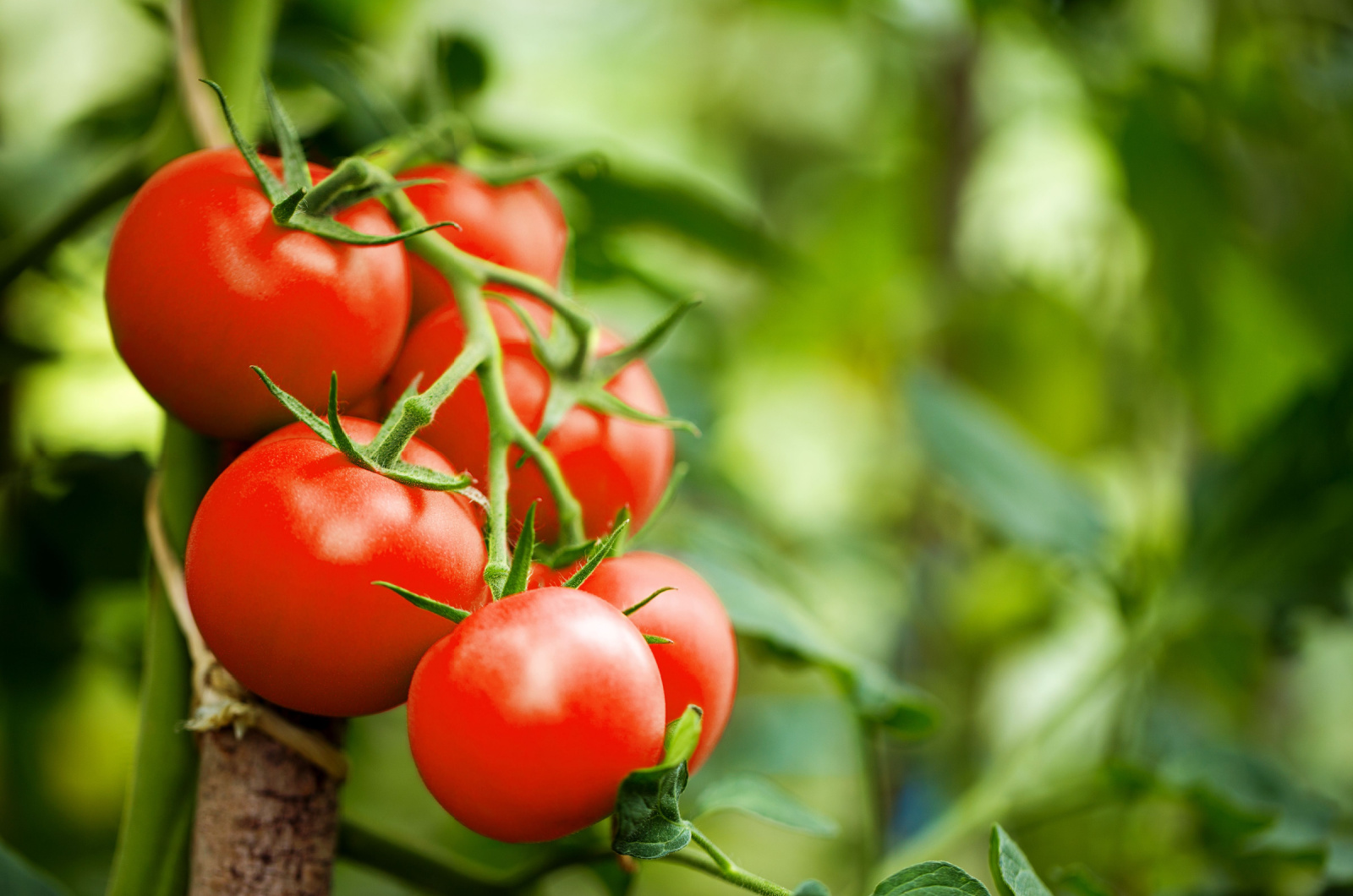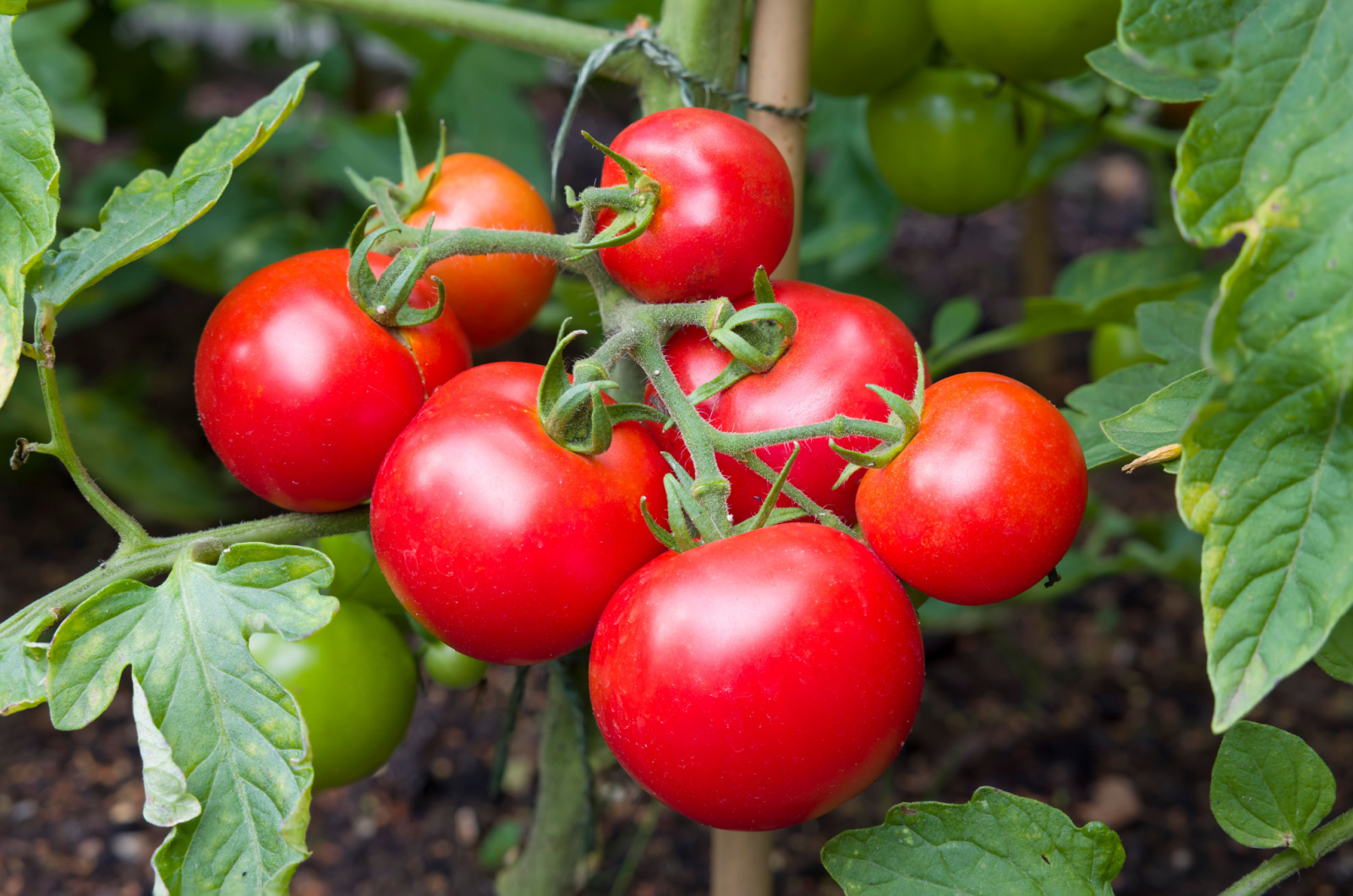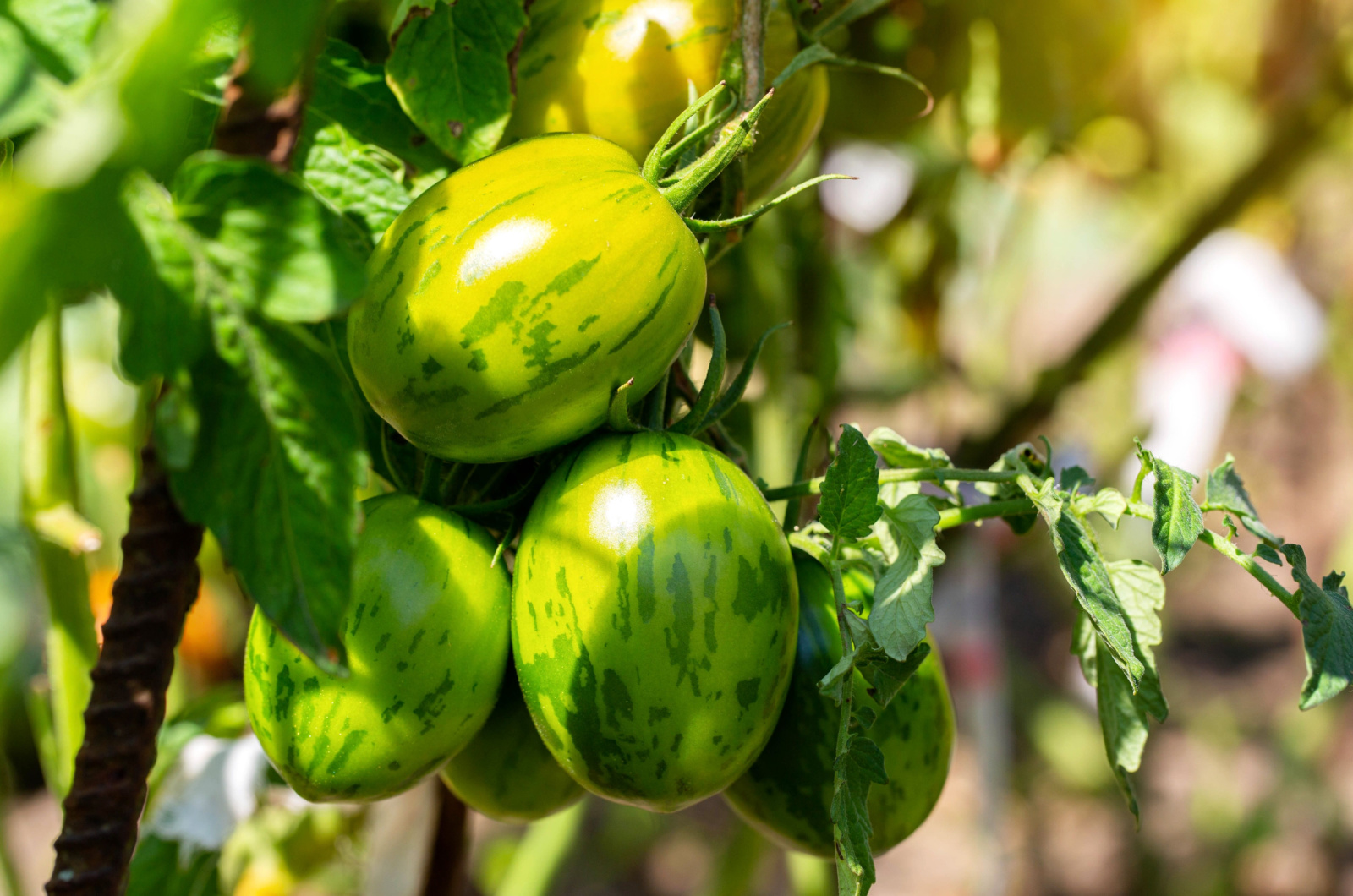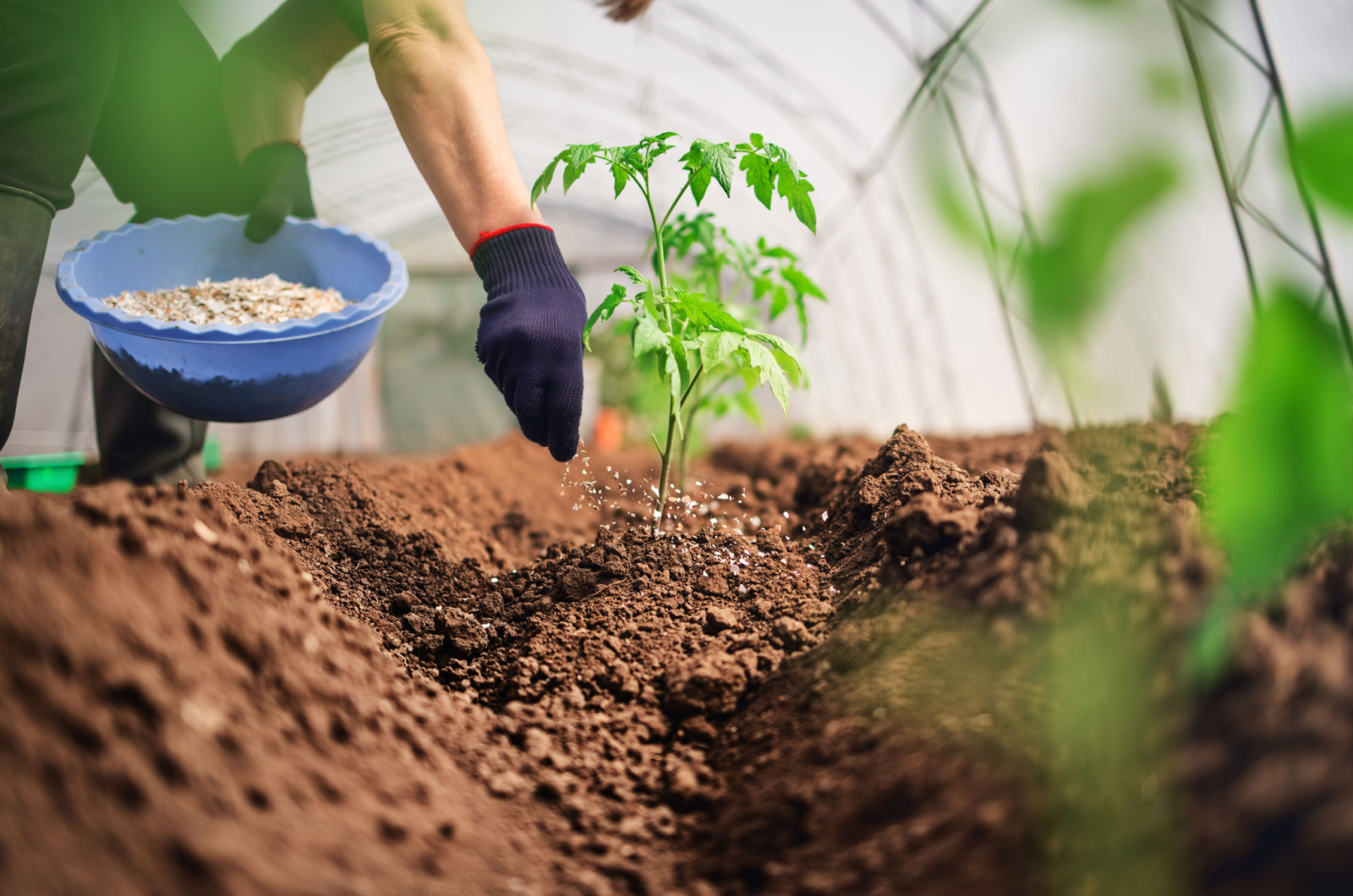There’s nothing like taking that first bite of your homegrown tomato. But not every variety tastes the same, and I had to try quite a few mediocre ones until I found the best-tasting options.
Of course, I can’t grow all of them, but Cherokee Purple and Brandywine are the staples of my garden that I plant every year.
If you’re tired of those artificial flavors you get in stores or paying too much money for organic tomatoes, try growing some of these varieties.
Your dishes will be healthier, much tastier, and you’ll see how rewarding the entire process is once you take that first bite.
Let’s get started!
1. Aunt Ruby’s German Green
One thing that’s unusual about this heirloom tomato is that it is completely green when ripe, or rather, amber green. And yet, it still has a strong sweet and fruity taste that can match most of the red varieties.
2. Berkeley Tie Dye
An heirloom tomato like Berkeley Tie Dye is bound to have a great flavor, and this one doesn’t disappoint. Its rich traditional, sweet and tangy flavor, and green skin striped with red and yellow lines is all that your dishes will ever need.
3. Black Cherry
One way to introduce more color to your dishes and salads is growing colorful tomatoes. Yellow and orange have almost become classics, but the dark burgundy color of the heirloom Black Cherry and its strong traditional tomato taste make it a great addition to your garden.
4. Black Krim
This heirloom tomato is a medium-sized variety that yields tangy, yet sweet and rich fruits. Its color is mahogany, almost maroon, but still has deep green shoulders even when ripe. Therefore, don’t wait until they disappear just to harvest them.
5. Brandywine
This tomato variety is popular for its rich, old-fashioned taste and large size. Its red, pink, or yellow color make it one of the most popular heirloom tomatoes to grow.
6. Carbon
Carbon is an heirloom variety with deep red flesh and light to deep purple shoulders. But it’s not just the color that makes it special. Its intense sweet and smoky flavor is everything your pizza and gourmet dishes will need.
P.S. It is considered crack-resistant so you won’t have to worry about low-quality fruits and end up looking for reasons tomatoes are splitting.
7. Cherokee Purple
People often wonder which variety to choose, Black Krim or Cherokee Purple, and the truth is that you can grow both of them.
When it comes to the Cherokee Purple, you’ll get a large fruit with a deep rosy color and rich, sweet, and savory flavor.
P.S. Both varieties are heirloom, so you know they’ve been grown for generations just for their delicious taste.
8. Chocolate Stripes
The sweet and earthy flavor make this heirloom tomato variety a desirable addition to any garden. But it’s not just the taste that makes it so special. Its deep red-brown skin color striped with olive-green lines makes it truly unique.
9. Costoluto Genovese
It may be difficult to pronounce, but once you try its refreshingly tangy and deep taste, you’ll be hooked! It is ideal for cooking because you can use it in salads fresh, cook it, or even learn some tomato canning recipes that will give you something to work with over winter.
Costoluto Genovese is an Italian heirloom variety with red skin that adorns flattened and ribbed fruits.
10. German Johnson
If you want a tomato plant to fill your entire tomato cage, then the pink-red German Johnson is the right choice. This heirloom variety originates from North Carolina and also has a creamy, fleshy, juicy, and sweet flavor that resembles that of Brandywine.
P.S. German Johnson fruits are huge and almost seedless.
11. Jaune Flamme
The size of an apricot, this orange French heirloom tomato variety is especially good for salads, savory dishes, and tomato sauces. A single plant will yield numerous cherries that taste incredibly sweet with just a hint of tartness when fully mature.
12. Speckled Roman
This variety is perfect for processing and canning due to its tangy taste. It is a bit drier than other varieties, meaty, and has very few seeds. It is a modern heirloom tomato with red skin and golden stripes, and is shaped like a pepper fruit.
13. Striped German
This is another marbled heirloom tomato with an incredible flavor. The Striped German is a beefsteak variety with a smooth and deeply fruity taste. The marbled insides are really something and the colorful yellow, orange, and red-striped skin doesn’t fall short.
14. Sungold
You can find this hybrid cherry variety on the list of the sweetest tomato types because its sweet and fruity flavor is something that no one can resist, especially when immature fruits taste rather tart. And its golden orange color is another reason to add it to your tomato collection.
15. Super Sweet 100
This variety is another hybrid with an incredibly sweet, almost sugary, and rich flavor. The bright red color makes this cherry tomato great for salads or a snack.
Understanding Tomato Varieties
There’s a host of tomato types out there, but they’re generally categorized into two branches: heirloom and hybrid tomatoes.
It is a general opinion that heirloom varieties taste better than hybrid ones, which is the main reason gardeners grow them.
Of course, that doesn’t mean that hybrid types taste bad. It’s just that they’ve been bred for different reasons.
The final decision is up to you. There are some delicious hybrid tomatoes that are disease-resistant, but almost none of them compare to the flavor you get from heirloom tomatoes. However, the latter are more susceptible to diseases.
Heirloom
Heirloom tomatoes are non-hybrid varieties that are usually grown locally and passed from generation to generation.
They’re mainly grown for their complex and distinctive taste, but are less disease-resistant than hybrids.
Some popular flavorful heirloom tomatoes include:
• Aunt Ruby’s German Green: famous for their amber-green color when fully ripe, Aunt Ruby’s German Green tomatoes are prized for their sweet and spicy taste.
• Black Krim: coming from the Isle of Krim, this dark-red, almost maroon, beefsteak tomato cultivar yields sweet, tangy, and rich-tasting fruits.
• Brandywine: if all you desire is a fruity, sweet, and slightly spicy flavor, then this rosy-pink Brandywine tomato is the way to go.
• Cherokee Purple: this tomato is often confused with Black Krim due to their similar shades, but it is more dark dusky-rose than maroon, and tastes rich and incredibly sweet, almost smoky.
Hybrid
Hybrid tomatoes were mainly bred to create disease-resistant varieties that won’t get infected with blight too easily.
Although their taste isn’t the first thing their breeders had in mind, there are still some flavorful varieties worth exploring.
Some notable hybrid tomatoes include:
• Black Pearl: The red-green color of this tomato turns almost purple when ripe and has a deep rich and sweet flavor.
• Sungold: For more color on your plate, go for these sweet and fruity golden orange tomatoes.
• Supersweet 100: This bright-red cherry tomato is a gardeners’ favorite due to its rich and sweet, almost sugary, flavor.
5 Factors That Influence Tomato Taste
Even if you choose the tastiest tomato variety out there, there are still some factors that determine its taste, such as ripeness, sugar and acidity content, etc.
Let’s check them out.
1. Ripeness
Ripeness is one of the deciding factors when it comes to tomato flavor. As the fruits mature, their sugar content increases and the acidity level decreases, making them sweeter and more flavorful.
Therefore, harvest your tomatoes once they are fully ripe if you want them to develop the best taste possible. Just remember that different varieties have different maturation times, so bear that in mind when choosing.
However, there are a few ways to make garden tomatoes ripen faster and allow you to enjoy the fullness of their flavor sooner.
2. Acidity And Sugar Content
The tomato flavor comes from the inside, of course, and it’s the sugar and acidity levels that determine the taste. Varieties with high acidity and sugar content are those we consider the best-tasting ones.
But this really depends on your preferences. Cherry tomatoes usually have a higher sugar content, which is why they have that sweet and fruity flavor (and they are my favorite).
But the balance is all that matters. Green tomatoes are rather acidic, so allow them to ripen a bit before harvesting them to get tastier fruits.
3. Sunlight And Weather
Plenty of sunlight and hotter temperatures will yield sweeter tomatoes. For instance, full sun and temperatures between 70 and 75°F will give you delicious fruits, but temperatures above 85 and 90°F will result in green and unripe fruit. (1)
4. Soil And Nutrition
Soil composition and nutrition can have a huge impact on tomato taste. These plants require fertile and well-draining mediums to keep their roots strong and healthy, allowing them to absorb the moisture and nutrients they need.
Of course, not all nutrients are the same. For instance, if you want to improve the quality of your tomato yield, watch out for potassium, sulfur, and boron deficiencies.
Potassium will make your fruit juicy, sulfur will improve its flavor, and boron will prevent cracking and uneven ripening. (2)
Test your substrate from time to time and amend it with the necessary nutrients if there’s any need.
5. Disease Resistance
Disease and pest-resistant tomatoes aren’t necessarily tastier, but they are better equipped to fight infections and infestations that affect the fruit flavor.
For instance, blight can cause lower acidity levels, which may or may not affect the final taste. (3)
Therefore, implementing proper pest management and choosing more disease-resistant varieties may yield you tastier fruit, but it will definitely lead to less work around your garden.
4 Growing Techniques For Tasty Tomatoes
Since the amount of sunlight, weather conditions, and the place you grow your tomatoes can affect their taste, here are some techniques that can help you get the most out of them!
1. Choose The Right Variety
If you want tasty tomatoes, choose the variety that has the best chance of succeeding in your garden or greenhouse.
That means going for disease-resistant types if you’ve combatted blight in the past.
Then, choose large or cherry varieties, or plant a couple of each. Cherry tomatoes are sweeter and fruitier, while large beefsteak tomatoes offer you that old-fashioned taste.
Just remember that each variety has some specifics when it comes to growth requirements, so make sure to meet them for optimal taste.
2. Planting And Fertilizing
When planting tomatoes, ensure that the soil in which they grow is rich in nutrients and organic matter. Then, opt for a location that gets plenty of sunlight (at least 6-8 hours per day).
Space each plant properly because low air circulation can increase humidity and the risk of fungal diseases or even fruits rotting.
Finally, don’t forget about fertilizing tomato plants. Proper nutrition will ensure the plant produces plenty of flowers and fruits, improve the flavor, and prevent cracking.
3. Irrigation And Mulching
Watering tomato plants isn’t rocket science. Under or overwatering can reduce the flavor because it stresses out the plant and it will have other things to worry about aside from producing tasty fruits.
Therefore, give your plants about 1-2 inches of moisture per week and irrigate them in the morning to allow the plant to absorb all the moisture it needs and for the excess to evaporate before night.
And to reduce the watering frequency, suppress weeds, and keep the tomato roots cool during hot summers, mulch your garden with a 2-3 inch layer of organic mulch. Just make sure not to place it too close to the main stem or it may cause rotting.
4. Trellising
Growing tomatoes on an arched trellis or any other stake has numerous benefits for these plants. It ensures proper airflow, reducing the risk of fungal infections, allows the entire plant to get sunlight, and saves you a lot of space.
Additionally, the fruits won’t touch the ground and be exposed to increased moisture, which will prevent them from rotting on the vines.
Finally, all of these practices will get you the most out of your tomatoes and provide you with the tastiest fruits your plants can produce.
3 Culinary Uses For Tomatoes
Once you harvest your tomatoes, it is time to decide what you want to do with them. You can preserve them by canning or turning them into a delicious sauce, or use them as they are.
Here are some ideas!
1. Sandwiches
The BLT is one of the best sandwiches out there, and tomatoes are an integral part of it. Slicer tomatoes such as Black Krim, Brandywine, and Cherokee Purple are some of the best types you can use.
They provide richness of taste intertwined with sugar and tartness, giving your cheeseburger or BLT everything it needs.
2. Salads
Salads provide an excellent way to show off your gardening skills by combining multiple tomato varieties to improve its taste. Combine the fruitiness of cherry tomatoes with the old-fashioned taste of slice varieties, and enjoy your salad.
Sungold, Black Cherry, and Supersweet 100 are some of the best tomatoes for this job, but you can use any variety you have to bring more flavor to regular salads.
3. Fresh Dishes
Dishes calling for fresh tomatoes, such as bruschetta and salsas, benefit from fully ripe and savory fruits.
Big Mama, San Marzano, and Roma are some of the best for the job. They have an excellent flavor, combining tanginess and sweetness, and contain very few seeds.
Therefore, to bring out the best of any dish, go for one of these extremely flavorful tomato varieties, implement the best growing techniques, and you’ll end up with savory fruit just waiting to be eaten.
References:
1. Why Aren’t My Tomatoes Ripening? (2012). Cornell Cooperative Extension: Cornell Vegetable Program.
2. Heckman, J. (2009). Can Soil Fertility Improve Tomato Flavor?. Rutgers, New Jersey Agricultural Experiment Station.
3. Nichols, J. (2014). Are Tomatoes and Potatoes with Late Blight Safe for Eating and Canning?. MSU Extension.

